Autonomous vehicles are expected to reduce traffic accidents caused by human errors[1], relieve traffic congestion, and reduce exhaust emissions[2], but the current high-level autonomous driving technology is still in the stages of research and testing and far from the market application. Furthermore, while being limited by the development level of technology, its application also depends on wide public acceptance and use[3] . Existing studies show that the acceptance of autonomous driving technology is affected by many factors, such as age, gender, cost, legal, and policy risks[4-5]. Most of those have shown significant gender effects, but few have focused on gender influence. According to the sixth census of the National Bureau of Statistics, the ratio of male-to-female citizens in China is 1.052. In general, the attitude of women toward new technology is less positive than that of men[6].Although the gender difference in new technology cognition is weak, it could still have a systematic impact. It is necessary to analyze the differences in the acceptance of autonomous driving technology from the perspective of gender, so as to form the relevant decision-making basis for promoting the development of autonomous driving technology.
A German survey[7] showed that men had a more positive attitude toward autonomous cars. Kyriakidis et al.[8] further confirmed that women were more concerned about the problems associated with autonomous cars based on 5000 questionnaires from 109 countries. Liu et al.[9] found that female participants showed lower perceived benefits and higher risk perception of autonomous driving technology in Xi’an and Tianjin. Payre et al.[10] surveyed 421 samples from France and concluded that men were more willing to use autonomous cars than women. In the above-mentioned literature, the subjects showed a consistent gender difference in the attitude and intention to use autonomous driving technology; moreover, the consistency has also been confirmed in different regions and cultural backgrounds. However, the differences in the deeper impact mechanism of the intention need to be further explored, especially based on the empirical analysis of China’s national conditions. Although Kyriakidis et al.[8] tried to explain the gender differences in terms of the intention to use autonomous cars, it was not enough to fully explain the inherent differences. It is necessary to establish an appropriate theoretical framework to analyze the differences in the influence mechanism for the acceptance of autonomous driving technology among the gender groups.
Theory of planned behavior (TPB) and technology acceptance model (TAM) are the main behavioral psychology theories applied in the research field of autonomous driving technology acceptance. However, explaining behavioral intention by a single theory is rather insufficient. The integration of the two provides a new approach for the effective improvement of the explanation of behavioral intention[11-12]. Furthermore, research on gender differences in the acceptance of autonomous driving technology by fusing the theories has yet to be seen with its influence path and and its effect is yet to be verified.
Therefore,based on TPB-TAM, multiple indicators and multiple causes (MIMIC) models are established for male and female groups, respectively. Empirical data was used to analyze the gender differences in influencing mechanisms. In particular, although the legal and policy risks may be of most concern to the public, with the improvement of relevant laws and regulations, it will not be the main problem in the future. Therefore, this paper only focuses on the acceptance of the technology itself, regardless of the laws and regulations.
1 Theoretical Model
Both TPB and TAM originate from rational behavior theory[11], and their common variables, attitudes, and intentions provide an opportunity for theoretical integration. In TPB, attitude, subjective norms (SN) and perceived behavioral control (PBC) jointly affect behavioral intentions in which attitude may be affected by subjective norms and perceived behavioral control. In TAM, behavioral attitude and perceived usefulness (PU) jointly affect behavioral intention. Among them, attitude may be affected by PU and perceived ease of use (PEU). Therefore, TPB and TAM are integrated, and the theoretical framework of the influencing factor model of acceptance of autonomous driving technology is constructed by combining the objective variables of individual socioeconomic attribute characteristics, as shown in Fig.1, and the path hypothesis referred to in Refs.[12-14].
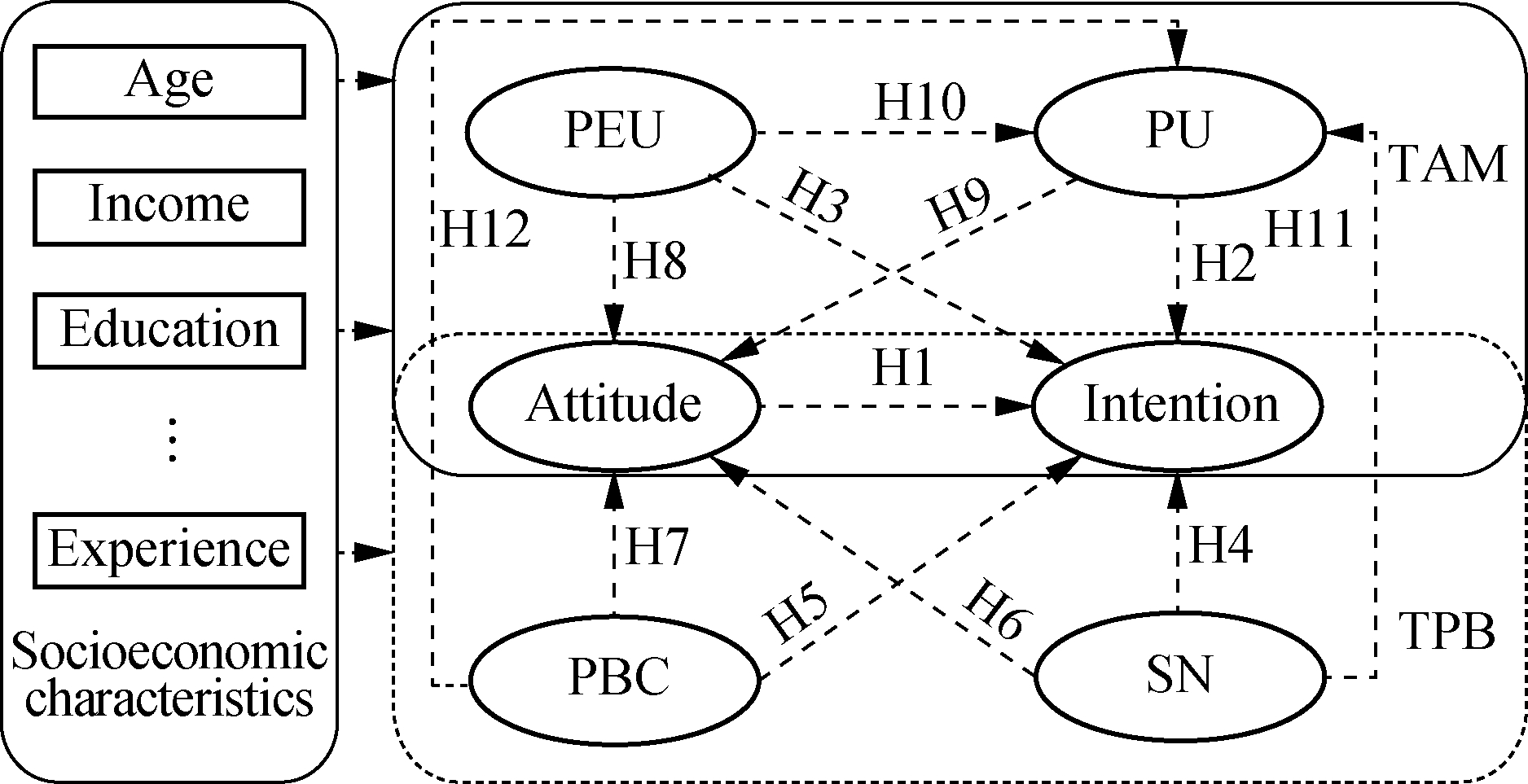
Fig.1 TPB-TAM theoretical framework of acceptance of autonomous driving technology
According to the theoretical framework in Fig.1, the latent variables of acceptance of autonomous driving technology are shown in Tab.1, in which the latent variables are measured by several question items, and each question item is constructed by a Likert five-scale (strongly disagree 1→strongly agree 5).
Tab.1 Latent variables
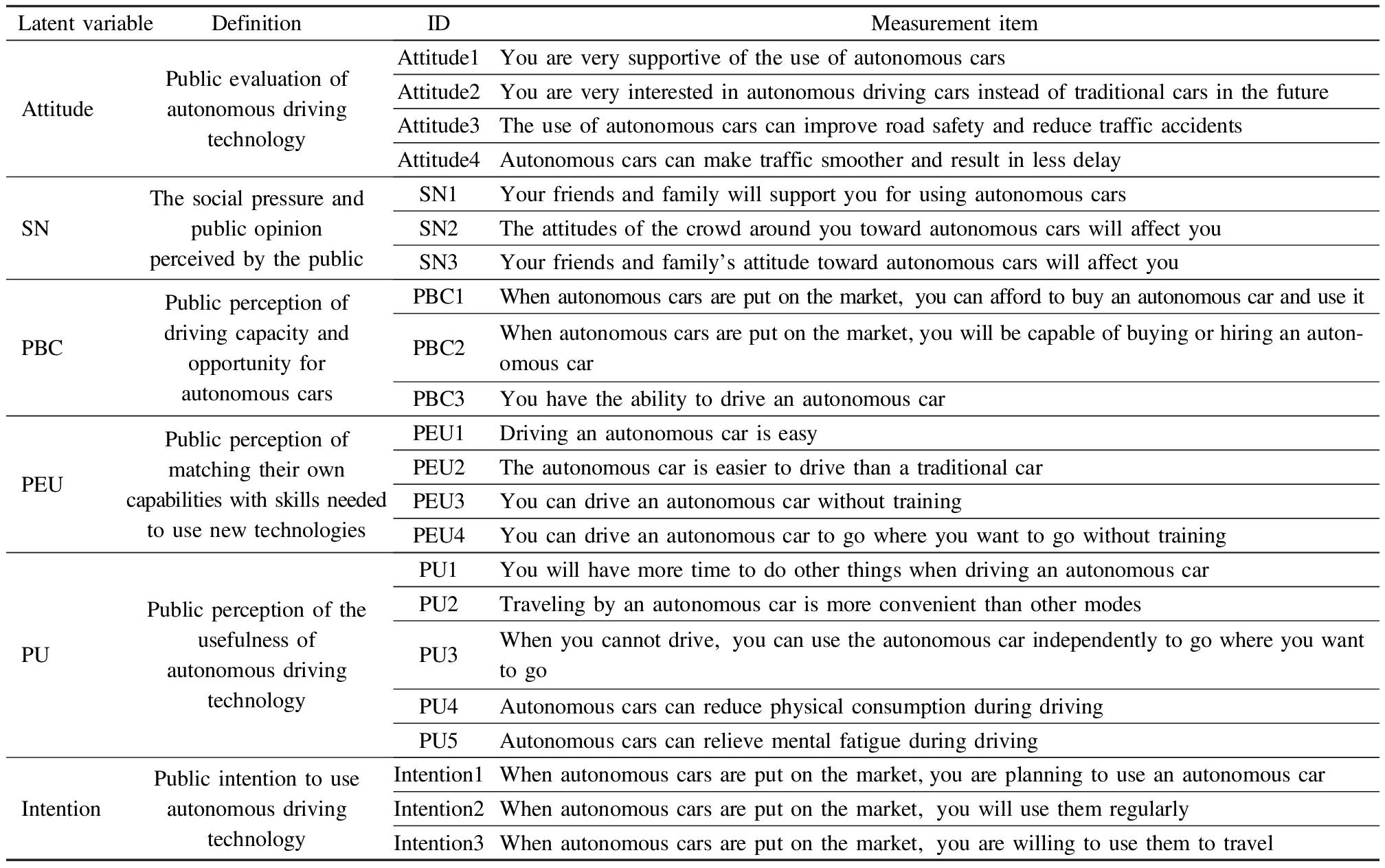
Latent variableDefinitionIDMeasurement itemAttitudePublic evaluation of autonomous driving technologyAttitude1You are very supportive of the use of autonomous carsAttitude2You are very interested in autonomous driving cars instead of traditional cars in the futureAttitude3The use of autonomous cars can improve road safety and reduce traffic accidentsAttitude4Autonomous cars can make traffic smoother and result in less delaySNThe social pressure and public opinion perceived by the publicSN1Your friends and family will support you for using autonomous carsSN2The attitudes of the crowd around you toward autonomous cars will affect youSN3Your friends and familys attitude toward autonomous cars will affect youPBCPublic perception of driving capacity and opportunity for autonomous carsPBC1When autonomous cars are put on the market you can afford to buy an autonomous car and use itPBC2When autonomous cars are put on the market you will be capable of buying or hiring an auton-omous carPBC3You have the ability to drive an autonomous carPEUPublic perception of matching their own capabilities with skills neededto use new technologiesPEU1Driving an autonomous car is easyPEU2The autonomous car is easier to drive than a traditional carPEU3You can drive an autonomous car without trainingPEU4You can drive an autonomous car to go where you want to go without trainingPUPublic perception of the usefulness of autonomous driving technologyPU1You will have more time to do other things when driving an autonomous carPU2Traveling by an autonomous car is more convenient than other modesPU3When you cannot drive you can use the autonomous car independently to go where you want to goPU4Autonomous cars can reduce physical consumption during drivingPU5Autonomous cars can relieve mental fatigue during drivingIntentionPublic intention to use autonomous driving technologyIntention1When autonomous cars are put on the market you are planning to use an autonomous carIntention2When autonomous cars are put on the market you will use them regularlyIntention3When autonomous cars are put on the market you are willing to use them to travel
2 Sample Statistics and Test
The questionnaire content is composed of two parts: the information survey of individual socioeconomic attributes and the subjective psychological survey of acceptance of autonomous driving technology. A total of 250 questionnaires were collected through face-to-face surveys at main gathering points, such as railway stations, high-speed railway stations, passenger stations, shopping malls, and schools. Of those, 231 valid surveys were obtained by eliminating invalid data. The response rate was 100% and the effective rate was 92.4%. The specific sample distribution is shown in Tab. 2.
Tab.2 Respondents’ profile
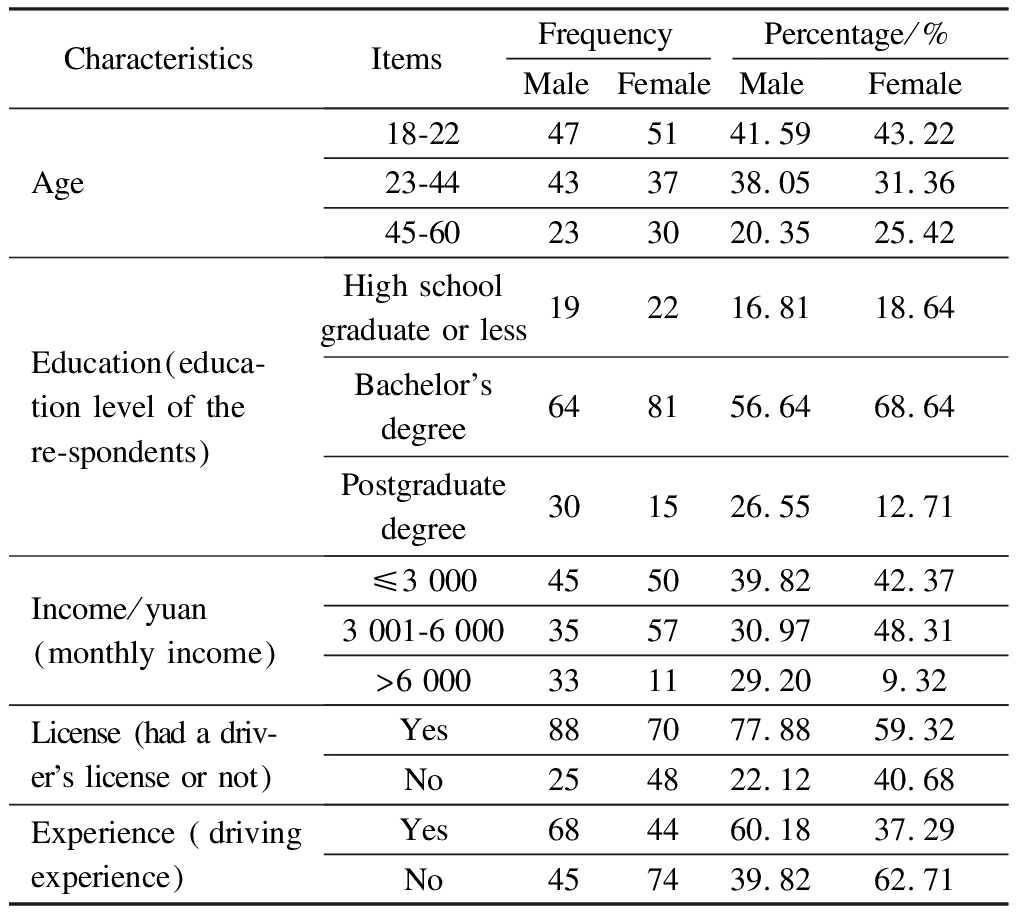
CharacteristicsItemsFrequencyPercentage/%MaleFemaleMaleFemaleAge18-22475141.5943.2223-44433738.0531.3645-60233020.3525.42Education educa-tion level of the re-spondents High school graduate or less192216.8118.64Bachelors degree648156.6468.64Postgraduate degree301526.5512.71Income/yuan monthly income ≤3 000455039.8242.373 001-6 000355730.9748.31>6 000331129.209.32License had a driv-ers license or not Yes887077.8859.32No254822.1240.68Experience driving experience Yes684460.1837.29No457439.8262.71
Tab. 2 shows the proportions of each socioeconomic characteristic category in the sample of men and women. According to Tab. 2, men account for 48.92% and women 51.08% of the total sample. Of those, men accounting for 56.64% have bachelor’s degrees, 29.20% earn more than 6 000 yuan per month, 77.88% of men have driving licenses, and 60.18% of them have actual driving experience. Compared with men, 68.64% of women have college or bachelor’s degrees, only 9.32% earn more than 6 000 yuan per month, 59.32% of women have driving licenses, only 37.29% of them have actual driving experience, and there are significant differences in socioeconomic characteristics between the two genders. Therefore, it is necessary to analyze the acceptance of autonomous driving technology by gender.
The reliability of latent variables is tested by factor analysis, Cronbach’s α coefficient, composite reliability (CR), and average variance extracted (AVE). The results are shown in Tab. 3. It can be seen from Tab. 3 that the principal component factors are unique, the eigenvalues are greater than 2.33, and the explained variance is greater than 70%. The coefficient α is greater than 0.85, which is higher than 0.7[15]. The AVE values are larger than 0.61, higher than 0.5[16] of the acceptable values. The CR values are all greater than 0.86, which exceed the acceptable value by 0.7[17]. In all, the designed scale has good reliability and validity.
Tab.3 Reliability and validity test results

LatentvariableGenderαAVECRFactor analysisEigenvalueProportion/%AttitudeMale0.9130.7250.9143.17579.37Female0.9030.7000.9033.10077.48SNMale0.9130.7840.9162.55485.14Female0.8560.6890.8662.33677.87PBCMale0.9270.8190.9312.62187.36Female0.8940.7690.9072.48682.85PEUMale0.8600.6140.8632.83270.80Female0.9090.7210.9123.15478.84PUMale0.9110.6780.9133.70074.02Female0.9210.7070.9233.81776.34IntentionMale0.9230.8050.9252.60886.93Female0.8960.7450.8972.48182.71
3 Influencing Factor Model
According to the theoretical framework of Fig. 1, a MIMIC model of the influence factors of male and female behavior is established to analyze the gender differences in the acceptance of autonomous driving technology.
The MIMIC model includes the structural equation reflecting the relationship between latent variables and the measurement equation expressing latent variables.
η=Λx+ζ
(1)
where η is n×1 dimensional vector of psychological latent variables of acceptance of autonomous driving technology, including attitude, SN, PBC, PEU, PU, and intention, and n is set to 6; x is k×1 dimensional vector of exogenous observable variables, including age, education, income, license, and experience, and k is set to 5; Λ is n×k dimensional parameter matrix; ζ is measurement error.
y=Γη+υ
(2)
where y is q×1 dimensional observable index vector; Γ is q×n dimensional parameter matrix; υ is measurement error.
The error terms ζ and υ meet the following conditions:
E(ζζT)=Ψ, E(υυT)=Θ, E(υ ζT)=0
(3)
4 Gender Differences in Acceptance of Autonomous Driving Technology
4.1 Model establishment and result analysis
The male and female MIMIC models were established by using Stata to analyze the influence of objective variables of individual socioeconomic characteristics on the psychological variables and the correlation between psychological variables. On the premise of ensuring the integrity of the theoretical framework, the model is modified. The goodness of fit of the final model is shown in Tab. 4.
Tab.4 Fitting index of the MIMIC model

Goodness of fitχ2/dfCFITLIRMSEASRMRMale1.2900.9620.9520.0510.063Female1.2780.9640.9550.0490.071Test standard 1 3 >0.9 >0.9 <0.06 <0.08
According to Tab. 4, the fitting indexes of MIMIC models are all above the test standard values, indicating that the established models are acceptable.
The results in the MIMIC model are divided into two parts. One is the relationship between the psychological latent variables, as shown in Fig. 2. The value on the path is the standardized path coefficient. The* in the upper right of the value represents P<0.05, ** is P<0.01, *** is P<0.001, and the value in brackets is the corresponding Z value.
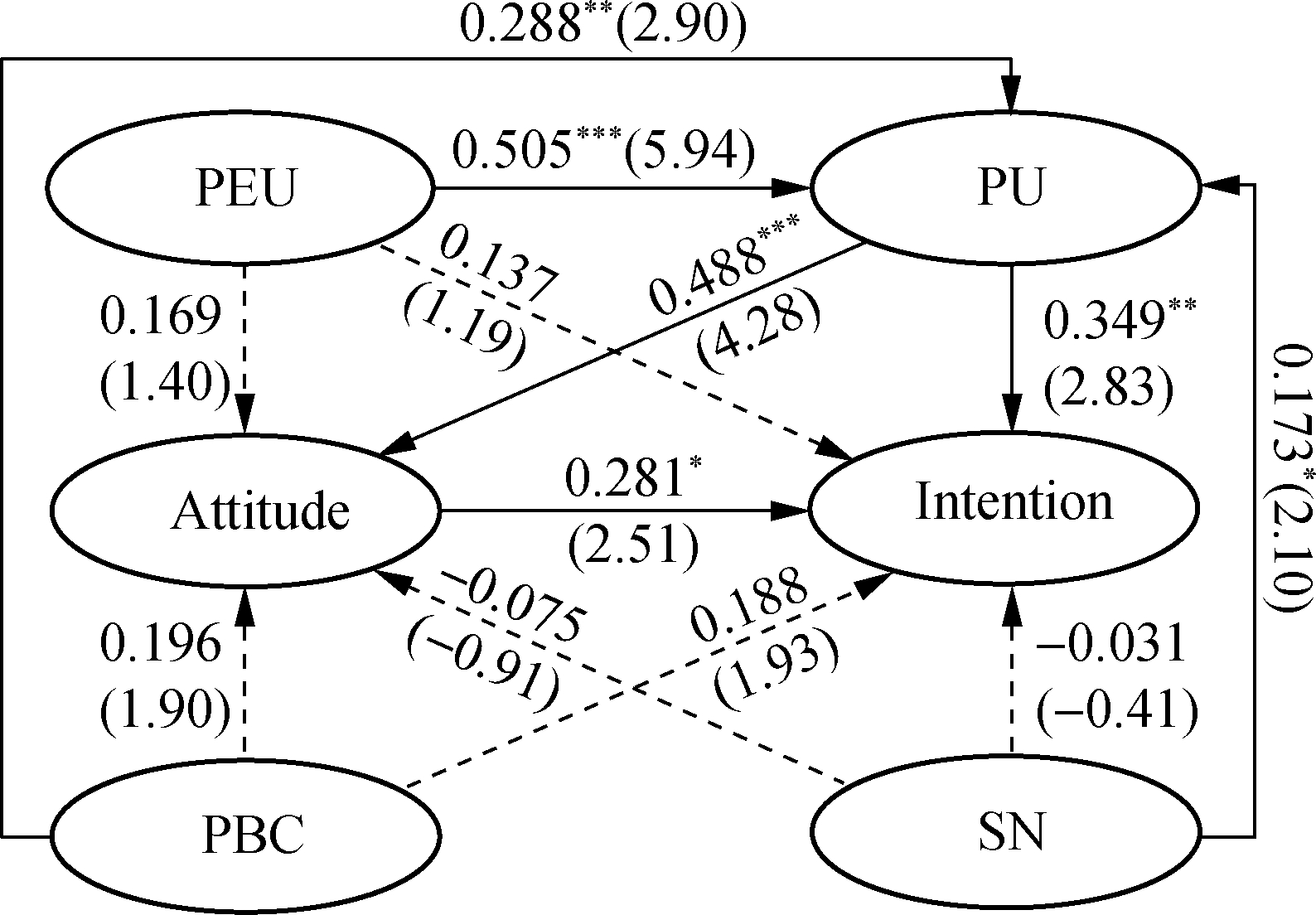
(a)

(b)
![]()
Fig.2 MIMIC models of autonomous driving technology acceptance. (a) Male; (b) Female
From Fig. 2(a), it can be seen that men’s attitudes toward autonomous driving technology and PU have a positive and significant impact on their behavior intentions. SN, PBC, and PEU have indirect effects on behavior intention through significant impact on PU; however, they have no direct significant impact on behavior intention. In addition, PU also has a significant effect on attitude and an indirect effect on behavioral intention.
According to Fig. 2(b), women’s behavioral intention regarding autonomous driving technology is only positively and significantly affected by PEU, while other variables bear no significant direct impact on it. In addition, PEU has a significant impact on PU, while PU has a significant impact on attitude, with other paths not significant.
The other part of the results is the influence of objective variables on latent variables. The path with a significant influence relationship is shown in Tab. 5. The first row of the table is the standard influence coefficient.
Tab.5 Effect of significant variables

LatentvariableAgeIncomeEducationMaleFemaleMaleFemaleMaleFemalePBC0.072-0.262∗0.241∗0.1450.238∗0.026 0.67 -2.34 2.28 1.36 2.47 0.28 PEU-0.0560.257∗0.217-0.077-0.0330.002 -0.48 2.25 1.90 -0.70 -0.31 0.02 PU0.1420.123-0.1090.005-0.0100.153∗ 1.67 1.41 -1.24 0.07 -0.13 2.24 〛Notes ∗P<0.05 the value in brackets is the Z value of the corresponding influence coefficient.
It can be seen from Tab. 5 that age has a significant negative impact on women’s PBC, and a significant positive impact on PEU. Monthly income has a significant positive impact on men’s PBC. Finally, education level has a significant positive impact on men’s PBC, and a significant positive impact on women’s PU.
4.2 Analysis of gender differences
Comparative analyses of the influence paths of gender, including autonomous driving technology acceptance and the influence of individual socioeconomic objective variables on psychological cognition, were conducted. According to the results of the mimic model, the hypothesis paths of the two groups are sorted out (see Fig. 3). The values on the histogram in the figure are the standard path coefficients of each path, *indicating that the corresponding path has a significant impact.
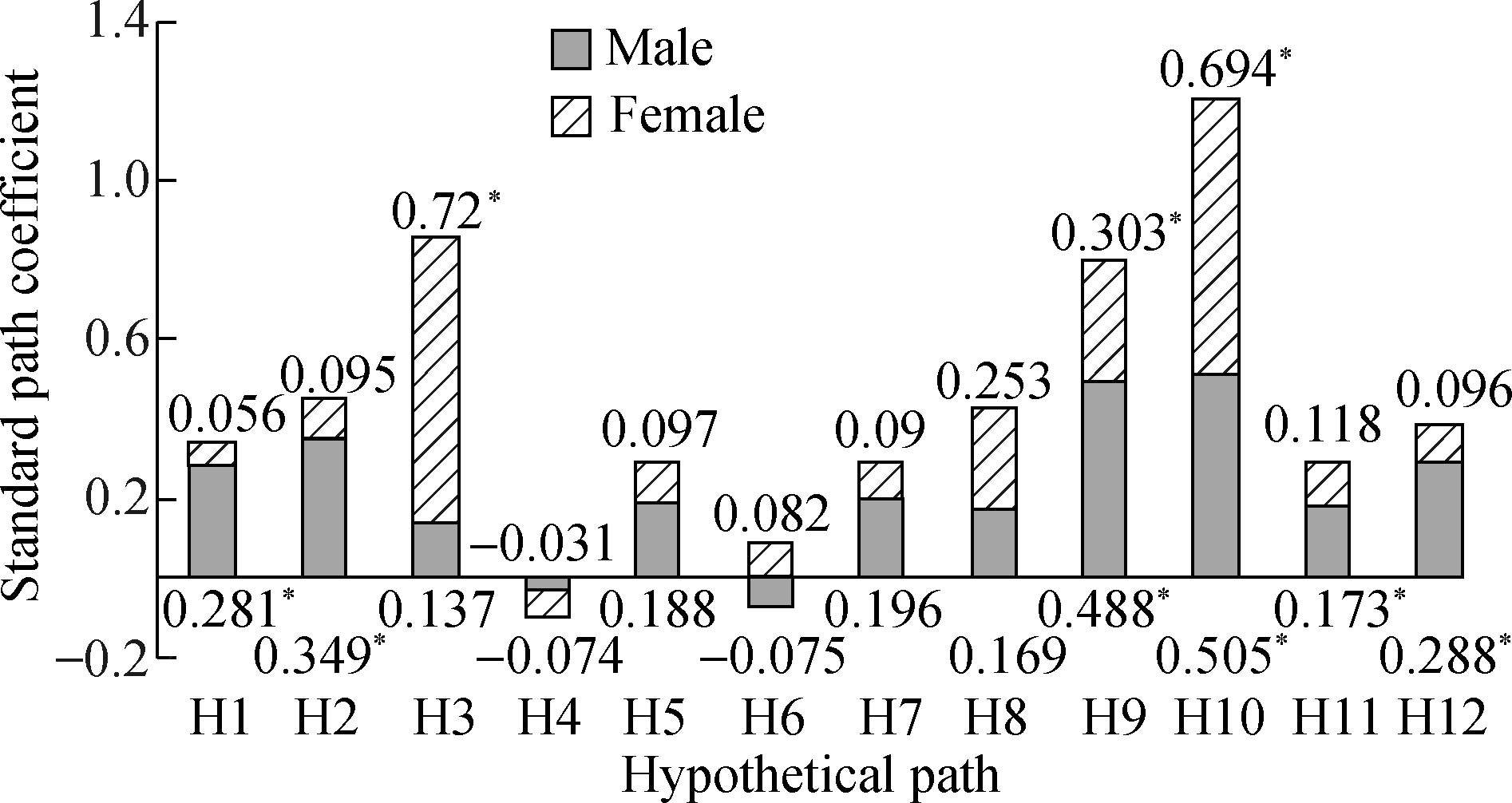
Fig.3 Difference of influence path of autonomous driving technology acceptance
According to Fig. 3, there are differences in the paths of autonomous driving technology acceptance, and there are more significant influence paths for men, including H1, H2, H9, H10, H11, and H12, with six paths in total. There are only three important paths for women, which are H3, H9, and H10. The number of factors influencing the intention is greater for men than women, and the significant influence path for males is relatively complex. It is directly or indirectly influenced by all other psychological variables. There is just one significant influence path for women; the key factor is PEU.
Between the two genders, there is a significant difference in the degree of acceptance of autonomous driving technology. Men have more significant influence paths, their values range from 0.173 to 0.505, while women have a less significant influence on the route. The coefficient of influence path is between 0.303 and 0.72, which is larger than men. The most influential path for women is H3: PEU → Intention, with a value of 0.72, which is higher than it is for men, H10: PEU → PU, with a value of 0.505, while men only indirectly affect the intention of PU.
The influence of objective variables of individual socioeconomic attributes on the psychological cognition of autonomous driving technology is mainly reflected in the influence of age, income, and education on PBC, PEU, and PU.
It can be seen from Tab. 5 that there are differences in the influence degree and direction between males and females. Among the paths with significant effects, the most significant differences are age → PBC, age → PEU and education → PU, with different degrees and directions. There is only a difference in the degree of influence between the two groups for income→PBC and education→PBC.
In terms of the degree of influence, age has a significant impact on PBC and PEU among women, and education has a significant impact on PU, indicating that the older women are, the more concerns they have about the opportunities and abilities to use autonomous driving technology. The higher the education level, the more concerns they have about the usefulness of the technology. Income and education have a significant impact on PBC in male groups, indicating that men with higher incomes and higher educational qualifications are more likely to have the opportunity to use autonomous cars. As a highly educated group, women are more concerned about PU, while men are more concerned about the opportunity and ability to use technology.
In terms of influence direction, age has a significant positive effect on PEU, as education has a significant positive effect on PU. Age has a significant negative effect on PBC among females, while the corresponding influence direction of men is just the opposite and not significant. It shows that the older women are, the more confident they are in their ability to use new technology. The more educated the women are, the more convinced they are in the usefulness of new technology, but the more worried they are about the opportunities to use new technology. The older the men are, the less confident they are in their ability to use new technology. The more educated the women are, the less likely they are to use new technology, but the more confident they are on the opportunity and ability to use new technologies. In contrast, women are more confident as they age. The higher the education level the women have, the higher recognition of usefulness they have compared with men. However, the older the women are, they have fewer opportunities to use autonomous driving technology compared with men.
5 Conclusions
1) The MIMIC model, which contains the objective variables of individual socioeconomic attributes and the subjective potential psychological variables regarding the acceptance of autonomous driving technology, has a good fit degree, which can reveal the internal relationship among the variables of the acceptance degree of autonomous driving technology. Compared with the demographic characteristic variable, the psychological variables have a more significant effect on the intention to use autonomous driving technology.
2) There are gender differences regarding the influence of objective variables of social and economic attributes on the acceptance of autonomous driving technology, mainly reflected in the degree of influence and direction differences of age, income, and education. The older one’s age, the more confident women are than men, but they are more worried about the chance of using autonomous driving technology. The higher the income, the more opportunities men will have to use autonomous driving technology than women. The higher the education level, the more attention women pay to PU, while the opportunity and ability to use the technology fall to men.
3) There are gender differences in the factors influencing the acceptance of the driving technology, mainly reflected in the differences of the paths and effects of the intention to use. The significant influence path of males is more complex than that of females, which is directly influenced by attitude and PU, and indirectly affects other psychological variables. The significant influence path of women is only the PEU. Compared with men, although the significant influence route of women is relatively small, the influence path coefficient is larger than that of males.
[1]Zhang T R, Tao D, Qu X D, et, al. The roles of initial trust and perceived risk in public’s acceptance of automated vehicles[J].Transportation Research Part C: Emerging Technologies, 2019, 98: 207-220. DOI:10.1016/j.trc.2018.11.018.
[2]Perrine K A,Kockelman K M, Huang Y T. Anticipating long-distance travel shifts due to self-driving vehicles[J]. Journal of Transport Geography, 2020, 82: 102547. DOI:10.1016/j.jtrangeo.2019.102547.
[3]Tang L, Qing S D, Xu Z G, et al. Research review on public acceptance of autonomous driving[J]. Journal of Traffic and Transportation Engineering, 2020, 20(2):131-146. (in Chinese)
[4]Jing P, Xu G, Chen Y X, et al. The determinants behind the acceptance of autonomous vehicles: A systematic review[J].Sustainability, 2020, 12(5): 1-26. DOI:10.3390/su12051719.
[5]Yuen K F, Wong Y D, Ma F, et al. The determinants of public acceptance of autonomous vehicles: An innovation diffusion perspective[J].Journal of Cleaner Production, 2020, 270: 121904. DOI:10.1016/j.jclepro.2020.121904.
[6]Etzioni S, Hamadneh J, Elvarsson A B, et al. Modeling cross-national differences in automated vehicle acceptance[J]. Sustainability, 2020, 12(22): 1-22. DOI:10.3390/su12229765.
[7]Hohenberger C, Spörrle M, Welpe I M. How and why do men and women differ in their willingness to use automated cars? The influence of emotions across different age groups[J]. Transportation Research Part A: Policy and Practice, 2016, 94: 374-385. DOI:10.1016/j.tra.2016.09.022.
[8]Kyriakidis M, Happee R, de Winter J C F. Public opinion on automated driving: Results of an international questionnaire among 5000 respondents[J]. Transportation Research Part F: Traffic Psychology and Behaviour, 2015, 32: 127-140. DOI:10.1016/j.trf.2015.04.014.
[9]Liu P, Zhang Y W, He Z. The effect of population age on the acceptable safety of self-driving vehicles[J].Reliability Engineering and System Safety, 2019, 185: 341-347. DOI:10.1016/j.ress.2019.01.003.
[10]Payre W, Cestac J, Delhomme P. Intention to use a fully automated car: Attitudes and a priori acceptability[J]. Transportation Research Part F: Traffic Psychology and Behaviour, 2014, 27: 252-263. DOI:10.1016/j.trf.2014.04.009.
[11]Chen C F, Chao W H. Habitual or reasoned? Using the theory of planned behavior, technology acceptance model, and habit to examine switching intentions toward public transit[J].Transportation Research Part F: Traffic Psychology and Behaviour, 2011, 14(2): 128-137. DOI:10.1016/j.trf.2010.11.006.
[12]Huang W. Research on the acceptance of fully autonomous vehicle based on theory of planned behavior and technology acceptance model[D]. Zhenjiang: Jiangsu University,2019. (in Chinese)
[13]Wang S Y, Fan J, Zhao D T, et al. Predicting consumers’ intention to adopt hybrid electric vehicles: Using an extended version of the theory of planned behavior model[J].Transportation, 2016, 43(1): 123-143. DOI:10.1007/s11116-014-9567-9.
[14]Jing P, Huang H, Ran B, et al. Exploring the factors affecting mode choice intention of autonomous vehicle based on an extended theory of planned behavior—a case study in China[J].Sustainability, 2019, 11(4): 1-20. DOI:10.3390/su11041155.
[15]Chen Y X, Chen L, Zha Q F, et al. A travel mode forecasting model based on low-carbon psychological latent variable logit model[J]. Journal of Highway and Transportation Research and Development, 2017, 34(9): 100-108,137. DOI: 10.3969/j.issn.1002-0268.2017.09.014 . (in Chinese)
[16]Qu W N, Sun H L, Ge Y. The effects of trait anxiety and the big five personality traits on self-driving car acceptance[J].Transportation, 2020: 1-17. DOI:10.1007/s11116-020-10143-7.
[17]Chen Y X, Chen L, Zha Q F, et al. Forecasting model of travel mode based on latent variable SVM[J]. Jonrnal of Southeast University (Natural Science Edition), 2016, 46(6):1313-1317. DOI: 10.3969/j.issn.1001-0505.2016.06.034. (in Chinese)